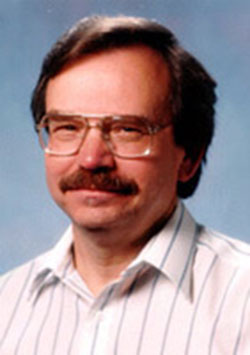1990 Distinguished Lecture Series: Michael J. Pavelich
Michael Pavelich
Biography
 Michael J. Pavelich received his B.S. in Chemistry from the University of Notre Dame in 1966 and his Ph.D. in Physical Inorganic Chemistry from the University of Buffalo in 1970. He then did research in enzyme kinetics at Cornell University for two years as a NIH Postdoctoral Fellow.
Michael J. Pavelich received his B.S. in Chemistry from the University of Notre Dame in 1966 and his Ph.D. in Physical Inorganic Chemistry from the University of Buffalo in 1970. He then did research in enzyme kinetics at Cornell University for two years as a NIH Postdoctoral Fellow.
His first faculty appointment was in the Chemistry Department of the University of Oklahoma. It is here that he became dissatisfied with the normal lecture approach to teaching, seeing how little impact it had on learning. While searching for answers he began to work with John W. Renner, a physicist also trained in Science Education.
Renner mentored him into this field, introducing him to learning theories and their applications, especially that of Jean Piaget. They were able to hire into the Chemistry Department Michael R. Abraham who was also trained in science education and educational research. Pavelich and Abraham became fast colleagues, creating two teaching lab formats, Guided and Open-ended Inquiry, that get students strongly into analytical (convergent) thinking in general chemistry laboratories. This work was eventually expanded into a commercial lab text that is still used by schools across the country.
Dr. Pavelich joined Colorado School of Mines in 1977 to do curriculum development and testing leading to teaching methods that promote higher-level thinking. He has implemented chemistry courses centered on convergent thinking practice by students. These include general, physical and senior inorganic chemistry.
Dr. Pavelich was instrumental is designing and getting approved the EPICS Program where students practice evaluation, real-world, problem solving. He was Director of the Program from its pilot stages through its implementation for all Mines freshmen and sophomores. He helped create and run the Seminar Series on Education at Mines that brings notable engineering educators to campus. He has received two awards for teaching and was promoted to full professor in the Chemistry Department in 1989. He has numerous publications in the Chemical Education and Engineering Education literature.
Abstract
The talk described how the educational innovations the author has championed came about. They all sprang from the goal of enhancing the higher-level thinking abilities of students. One taxonomy of thinking and one model of intellectual development were central to the innovations.
Blosser’s taxonomy describes four types of thinking: recall, convergent, divergent and evaluative. Inspection shows that professionals do all four types and must do each well to be productive; yet, recall and only some convergent thinking typify undergraduate education. To better prepare students for their professions we must have them consistently practice and refine all four types.
This analysis led the author to explicitly build practice with new convergent questions into all his chemistry courses, from the simple application of ideas to new situations in general chemistry to the analysis of the useful bounds of theories in senior inorganic. It also led to the revolutionary approaches to general chemistry labs called Guided Inquiry and Open-ended Inquiry that he developed with colleague M. R. Abraham. Specific examples of these curricular changes were presented.
The desire to give students practice and instruction with Evaluative thinking (open-ended or real-world problem solving) led to the creation of the EPICS Program, where students work in teams on open-ended problems submitted by industry. This program has shown good results in fostering higher-level thinking abilities, has prospered for a decade and has received recognition in engineering education circles on a national level.
While teaching in EPICS students’ remarkable misconceptions about real-world problems become obvious. They are explained by Perry’s Model of Intellectual Development that maps the progression toward higher-level thinking that should occur in college. At Perry’s level 2, people do not really believe that there are open-ended problems, they see all situations as right or wrong. Further, they see experts as having these answers. They don’t use evidence to justify decision, they use experts. Perry calls these people dualists.
At level 4, the person does see that many questions are legitimately uncertain, but they cannot see how one can make a decision in such as situation. Their common statement is that “everyone is entitled to their own opinion”. Although they often use evidence well, they don’t trust it. At Level 6, the person does see most questions as being legitimately open-ended, understands how to use evidence and the comparison of alternatives to find the better answer in context, and understands that value systems play an important part in such decisions.
It is clear to teachers of EPICS and senior design that our students often start with remnants of dualism in their thinking and overall, even as seniors, may only progress to Level 4 by graduation. The Perry Model gives faculty a good working definition of higher level thinking and a definable goal for undergraduate education: getting as many students as possible to progress to Level 6 by graduation. It also allows measurement toward that goal.
A research plan to measure the effect of the Mines curriculum, especially the EPICS and other design courses, was outlined. Finally, how the Perry Model can be used to refine how we teach students in design courses was discussed.